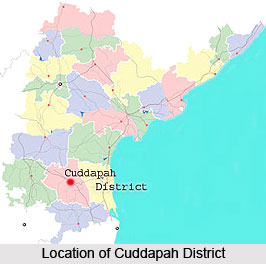 Geographically, Cuddapah district is situated within 13.43` and 15.14` of the northern latitude and 77.55` & 79.29` of the eastern longitude. The district spreads northwards beneath the Western slopes of the Eastern Ghats mountain range as a rough parallelogram, dented deeply in its Southern, Western and Northern boundaries. It is surrounded by Kurnool district on the North, Chittoor district on the South, Nellore district and Prakasm district on the East and Anantpur District on the West. The total geographical area of the Kadala district is 15,379 sq. Kms. Cuddapah district is said to be the heart of the Rayalaseema as it is centrally located and well connected with the 4 districts of Rayalaseema. The climate of Kadapa district, as it is also known, is such that it experiences its minimum temperature, in November-January, at about 28-30 C. The hottest temperature ranges between the 40-45 ranges during April-May. Based on the Agro-climatic conditions the District falls both in Southern and scarce rainfall zone. Kadapa is one of the districts in Rayalaseema area, with an uneven, isolated rainfall in different parts of the district and with large dry tracts. The District`s normal rainfall is 700 mm and its actual rainfall varies from 400+ to 800+ mm. It gets its major portion of rainfall (around 60%) during June-September period through South-West Monsoon. More than 30% of its average rainfall comes from North-East Monsoon during October-December. It gets its remaining 10-15% of its rainfall during Winter Period (January-February) and in Hot Weather Period (March-May).
Geographically, Cuddapah district is situated within 13.43` and 15.14` of the northern latitude and 77.55` & 79.29` of the eastern longitude. The district spreads northwards beneath the Western slopes of the Eastern Ghats mountain range as a rough parallelogram, dented deeply in its Southern, Western and Northern boundaries. It is surrounded by Kurnool district on the North, Chittoor district on the South, Nellore district and Prakasm district on the East and Anantpur District on the West. The total geographical area of the Kadala district is 15,379 sq. Kms. Cuddapah district is said to be the heart of the Rayalaseema as it is centrally located and well connected with the 4 districts of Rayalaseema. The climate of Kadapa district, as it is also known, is such that it experiences its minimum temperature, in November-January, at about 28-30 C. The hottest temperature ranges between the 40-45 ranges during April-May. Based on the Agro-climatic conditions the District falls both in Southern and scarce rainfall zone. Kadapa is one of the districts in Rayalaseema area, with an uneven, isolated rainfall in different parts of the district and with large dry tracts. The District`s normal rainfall is 700 mm and its actual rainfall varies from 400+ to 800+ mm. It gets its major portion of rainfall (around 60%) during June-September period through South-West Monsoon. More than 30% of its average rainfall comes from North-East Monsoon during October-December. It gets its remaining 10-15% of its rainfall during Winter Period (January-February) and in Hot Weather Period (March-May).
The soil of the district has been classified into red ferruginous soil and black soil. These two classes can be sub divided into clay, loam sand with finer distinctions. They range from poor to fertile. Red soils occupy 53% of the cultivated area and are mostly situated in L. R. Palli, Rayachoty, Rajampet, Pulivendla and Kodur Mandals. These soils have a low nutrient status. Black soils covered nearly 47% of the cultivated area and are generally associated with clay content located in Muddanur, Jammalamadugu, Proddatur, Mydukur, Pulivendla and Kamalapuram Mandals.
The district is blessed with a series of beautiful valleys through which holy rivers like Pinakini (Pennar), Papaghni, Chitravathi, Mandavya, Cheyyeru cut across the district. The river Pennar is the most important river flowing right through the District whose legend is incorporated in a sasanam (inscription) at Gandikota. The Seshachalam range of hills passes through this district and is ultimately crowned with the Holy shrine of Tirumala in the Chittoor district.
The forests of the district are of a dry deciduous type. Its most important species is the famous pterocaropus santalinus or red sanders. Since this is the only district of the country in which this species occurs, a positive conservation to extend them has been evolved. These forests fall under three zones wise those of Teral or Fuel Forests upto an elevation of hundred feet, Hill Forests or Red Sanders lying between the elevation of 800 and 2000 feet and Shoreaeugenla occupying elevations above 2000 feet.
The major agricultural crops grown in the region are Paddy, Groundnut, Red gram, cotton and Bengal Gram. Among the fruit crops grown here, the major ones are Mango, Citrus, Banana, Melons and Papaya. Turmeric, Onion, Chillies, Coriander, Vegetables and Chrysanthemum are other commercial crops grown in the district. The major irrigation sources in the district that provide water to the agricultural produce are K-C canal, the Mydukur and the Chapadu Project, the upper Sagileru and lower Sagileru and the Pincha Projects.
The district of Cuddapah is rich in minerals. The major minerals in the district are Berytis, limestone and asbestos. The high grade asbestos of Chrysotile variety, Berytis and limestone suitable for manufacture of cement are present in the district in large quantities. It also possesses important deposits of white clay, small deposits of small iron ore, ochre and steatite and abounds in construction material. Apart from Major Minerals, Minor Minerals are Napa Slabs, Road Metal, Building Stone, Marble, Mosaic Chips and Rehmatti are also in the District. There are extensive outcrops of limestones, Dolomites, Granite and Quartzites in major parts of the district, which could be utilised as building material.



















